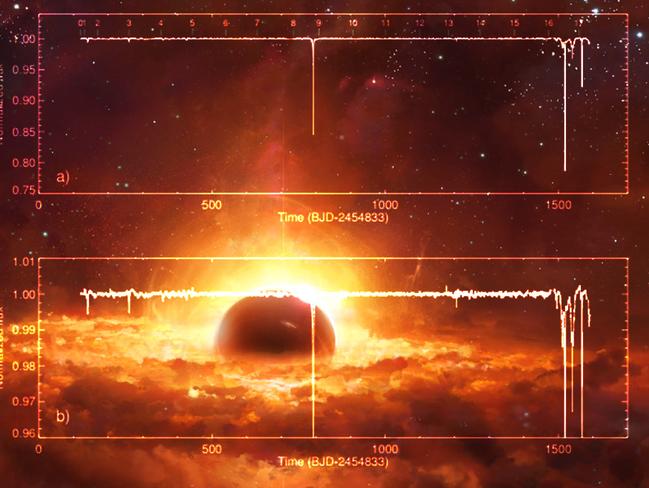SETI search of strange KIC 8462852 star finds no alien signals
SETI scientists have been quietly listening to a weirdly flickering star since it sparked intense speculation about alien megastructures last month. So far, ET’s not phoned home.

SETI scientists have been quietly listening to a weirdly flickering star since it sparked intense speculation about alien megastructures last month. So far, ET’s not phoned home.
The Search for Extraterrestrial Intelligence (SETI) last month turned the 42 radio telescopes of the Allen Telescope Array in California towards KIC 8462852 after a band of amateur astronomers pointed out how unusual it was.
NASA’s Kepler Space Telescope had captured the dim light of the distant star flickering. But not in the way one would expect. Instead of regular pulses caused by the orbit of planets, this star was erratic.
Such a light signal has long been anticipated as the possible first sign of an immense effort of alien technology — a Dyson sphere. This is where an advanced civilisation builds an enormous, solar-system-scale solar array to harvest as much energy as possible from its star.
EXPLORE MORE: What’s the fuss about this strange, stuttering star?
SETI began to listen for the telltale chatter of artificial radio signals on October 15. A fortnight later, it has reported finding no narrowband or broadband signals between the key 1 and 10GHz microwave bands.
Signals fitting those parameters would likely be artificial.
Narrow-band radio signals at 1GHz would represent a kind of intergalactic lighthouse. Broad-band signals could represent emissions from spaceship propulsion systems.
“The history of astronomy tells us that every time we thought we had found a phenomenon due to the activities of extraterrestrials, we were wrong,” senior SETI astronomer Seth Shostak said in a statement. “But although it’s quite likely that this star’s strange behaviour is due to nature, not aliens, it’s only prudent to check such things out.”

So what causes this star to go from bright to dramatically dim on a schedule ranging anywhere between five and 80 days?
Nobody knows. Yet.
So far astronomers feel the most likely explanation is it is being caused by a swarm of comets, kicked up by a nearby wandering star, spiralling back down towards their host star.
But even aliens can’t be completely ruled out. Yet.
Whatever is causing KIC 8462852’s odd light fluctuations is of interest to all aspects of astronomy. So more and more telescopes will be turning towards the star, 1480-light-year away in the direction of the constellation of Cygnus, to find out what they can.
By breaking the star’s light and natural radio frequencies into their component spectra, astrophysicists hope to soon determine if the light is being blocked by solid objects or dust clouds.




